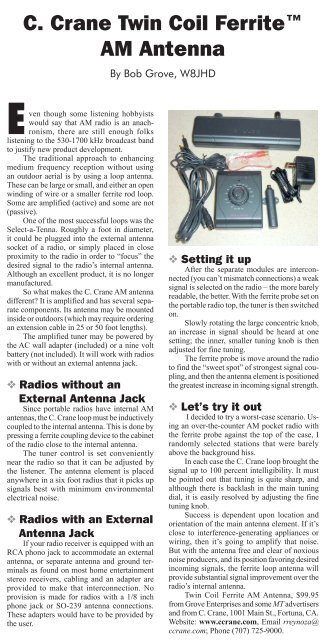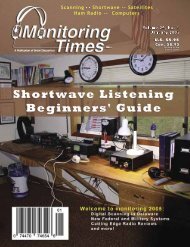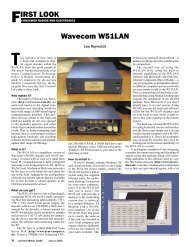Twin Coil Ferrite AM Antenna Review - C. Crane Company
Twin Coil Ferrite AM Antenna Review - C. Crane Company
Twin Coil Ferrite AM Antenna Review - C. Crane Company
You also want an ePaper? Increase the reach of your titles
YUMPU automatically turns print PDFs into web optimized ePapers that Google loves.
C. <strong>Crane</strong> <strong>Twin</strong> <strong>Coil</strong> <strong>Ferrite</strong><br />
<strong>AM</strong> <strong>Antenna</strong><br />
By Bob Grove, W8JHD<br />
Even though some listening hobbyists<br />
would say that <strong>AM</strong> radio is an anachronism,<br />
there are still enough folks<br />
listening to the 530-1700 kHz broadcast band<br />
to justify new product development.<br />
The traditional approach to enhancing<br />
medium frequency reception without using<br />
an outdoor aerial is by using a loop antenna.<br />
These can be large or small, and either an open<br />
winding of wire or a smaller ferrite rod loop.<br />
Some are amplified (active) and some are not<br />
(passive).<br />
One of the most successful loops was the<br />
Select-a-Tenna. Roughly a foot in diameter,<br />
it could be plugged into the external antenna<br />
socket of a radio, or simply placed in close<br />
proximity to the radio in order to “focus” the<br />
desired signal to the radio’s internal antenna.<br />
Although an excellent product, it is no longer<br />
manufactured.<br />
So what makes the C. <strong>Crane</strong> <strong>AM</strong> antenna<br />
different? It is amplified and has several separate<br />
components. Its antenna may be mounted<br />
inside or outdoors (which may require ordering<br />
an extension cable in 25 or 50 foot lengths).<br />
The amplified tuner may be powered by<br />
the AC wall adapter (included) or a nine volt<br />
battery (not included). It will work with radios<br />
with or without an external antenna jack.<br />
❖ Radios without an<br />
External <strong>Antenna</strong> Jack<br />
Since portable radios have internal <strong>AM</strong><br />
antennas, the C. <strong>Crane</strong> loop must be inductively<br />
coupled to the internal antenna. This is done by<br />
pressing a ferrite coupling device to the cabinet<br />
of the radio close to the internal antenna.<br />
The tuner control is set conveniently<br />
near the radio so that it can be adjusted by<br />
the listener. The antenna element is placed<br />
anywhere in a six foot radius that it picks up<br />
signals best with minimum environmental<br />
electrical noise.<br />
❖ Radios with an External<br />
<strong>Antenna</strong> Jack<br />
If your radio receiver is equipped with an<br />
RCA phono jack to accommodate an external<br />
antenna, or separate antenna and ground terminals<br />
as found on most home entertainment<br />
stereo receivers, cabling and an adapter are<br />
provided to make that interconnection. No<br />
provision is made for radios with a 1/8 inch<br />
phone jack or SO-239 antenna connections.<br />
These adapters would have to be provided by<br />
the user.<br />
❖ Setting it up<br />
After the separate modules are interconnected<br />
(you can’t mismatch connections) a weak<br />
signal is selected on the radio – the more barely<br />
readable, the better. With the ferrite probe set on<br />
the portable radio top, the tuner is then switched<br />
on.<br />
Slowly rotating the large concentric knob,<br />
an increase in signal should be heard at one<br />
setting; the inner, smaller tuning knob is then<br />
adjusted for fine tuning.<br />
The ferrite probe is move around the radio<br />
to find the “sweet spot” of strongest signal coupling,<br />
and then the antenna element is positioned<br />
the greatest increase in incoming signal strength.<br />
❖ Let’s try it out<br />
I decided to try a worst-case scenario. Using<br />
an over-the-counter <strong>AM</strong> pocket radio with<br />
the ferrite probe against the top of the case, I<br />
randomly selected stations that were barely<br />
above the background hiss.<br />
In each case the C. <strong>Crane</strong> loop brought the<br />
signal up to 100 percent intelligibility. It must<br />
be pointed out that tuning is quite sharp, and<br />
although there is backlash in the main tuning<br />
dial, it is easily resolved by adjusting the fine<br />
tuning knob.<br />
Success is dependent upon location and<br />
orientation of the main antenna element. If it’s<br />
close to interference-generating appliances or<br />
wiring, then it’s going to amplify that noise.<br />
But with the antenna free and clear of noxious<br />
noise producers, and its position favoring desired<br />
incoming signals, the ferrite loop antenna will<br />
provide substantial signal improvement over the<br />
radio’s internal antenna.<br />
<strong>Twin</strong> <strong>Coil</strong> <strong>Ferrite</strong> <strong>AM</strong> <strong>Antenna</strong>, $99.95<br />
from Grove Enterprises and some MT advertisers<br />
and from C. <strong>Crane</strong>, 1001 Main St., Fortuna, CA.<br />
Website: www.ccrane.com, Email rreynoza@<br />
ccrane.com; Phone (707) 725-9000.
















